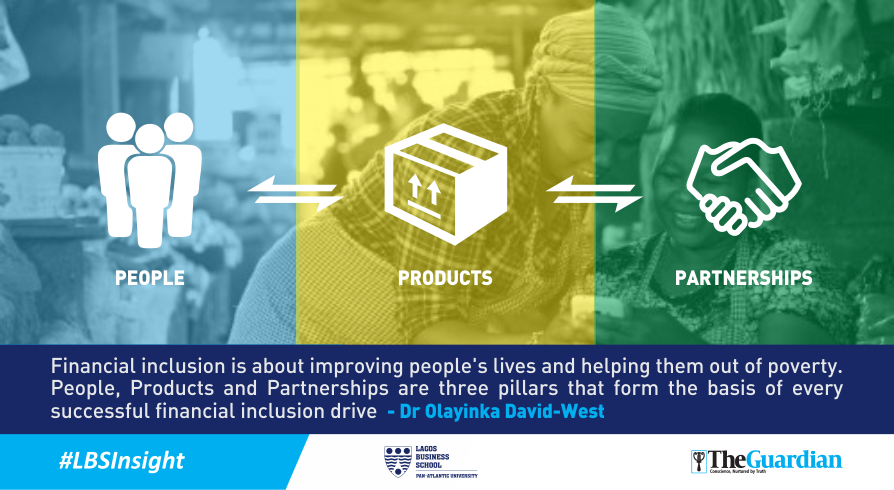With more than 36 million Nigerian adults living without bank accounts, financial inclusion looks like an enormous task ahead of the industry.
And it is.
Amidst the multi-dimensional challenges and many moving parts within and outside the ecosystem, it can be overwhelming to contemplate realistic approaches to the problem. However, three pillars (otherwise known as the 3Ps of financial inclusion) form the basis of every successful financial inclusion drive.
They are People, Products and Partnerships.
People
Financial inclusion is about improving people’s lives and helping them out of poverty. Achieving this involves, among a host of things, moving them away from cash transactions to digital money. In Africa, mobile money is the flagship digital money vehicle, but so far, Nigerians have been slow to adopt it — 2018 penetration rate was about 3.3 per cent (EFInA 2018), the key obstacles to adoption being access and low awareness.
To overcome the access hurdle, we have to build a sustainable agent network across the country (especially rural areas). Experts estimate this number at 180,000 agents to adequately serve the adult population. This agent network will complement the other Financial Service Points (FSPs) such as ATMs, POS terminals and bank branches which are currently insufficient to serve the country’s almost 100 million adult population.
We also need to improve consumer trust in formal financial institutions. Appropriate preventive mechanisms, as well as advanced complaints resolution systems, are necessary to ensure customers’ funds are safe and secure. Also, if people are not educated about the options available to them (awareness), they will not change their behaviour. Right now, 83.3 per cent of the adult population is yet to even hear about mobile money, according to EFInA. Therefore, awareness campaigns are required along with financial literacy programmes which will encourage mobile money adoption.
Products
When it comes to financial services, there is no “one size fits all”. It is true that people need financial services, but these services have to meet their specific needs.
Due to customs and traditions, financial services needs vary across cultures and regions. These needs also vary across gender and other demographic characteristics, and this is even more pertinent as the World Bank Findex revealed the urgent need for intervention in financial inclusion for women.
Furthermore, our target audience – the unbanked and underserved – face unique obstacles and therefore, have unique financial needs. Financial service providers will do well to adopt a human-centred design that builds financial products based on a proper understanding of the customer — their needs, challenges, habits and lifestyle. This way, a product-market fit would be easily achieved, and adoption would increase.
It is equally important to keep in mind that serving unbanked or underserved populations involves the creation of low-cost financial products since by default, these are mostly low-income citizens.
Partnerships
With more than 36 million financially excluded Nigerians, financial inclusion cannot happen at the desired scale without strategic partnerships. Partnerships enable actors to progress faster as they leverage each other’s strengths and expertise. These partnerships are established in order to improve product appropriateness, achieve lower costs and reach more unbanked citizens — goals with special relevance to financial inclusion.
Although it is an important part of the mix, partnerships do not have to be exclusively about banks joining forces with fintechs. Partnerships can be cross-sectional: public-private sector partnerships, government-bank partnerships, financial and non-financial institution partnerships, and so on.
Conclusion
These 3Ps are handy and constitute the foundation of any successful financial inclusion campaign. If we can understand the unbanked and underbanked (people), if we can figure out what type of financial services would meet their needs and fit their lifestyle (products), and if we can forge strategic partnerships which will deliver these products to them, financial inclusion would be a reality and we would be closer to achieving our 2020 goals.
Do you have any thoughts on these three pillars? In what other ways can financial inclusion be improved?



Whao! This is quite interesting.
Advancing financial inclusion is truly based on the principles stated above.They are quite essential in developing the right strategy towards achieving financial inclusion.
Truth be told, driving this shouldn’t be limited to what the government can do or efforts by the regulatory body. There must be private investments in advocacy and product development for sustainability.
financial inclusion is not a product push or creating market for financial houses instead,helping majority of the undeserved get the best from life. We can’t limit it to paper publication or mere policy frame work. we must have people on the field to implement every developed strategy through open campaigns and advocacy.
Exclusion is prevalence in African especially in Nigeria due to our ever increasing population and level of illiteracy, we must rise up to the demand and savage our self from the worry of digital future closer than we can ever imagine. The campaign must thrive beyond the brick and walls of institutions, bank, coordinating bodies down to the underserved.
Join us at @Towards financial inclusion on Instagram.